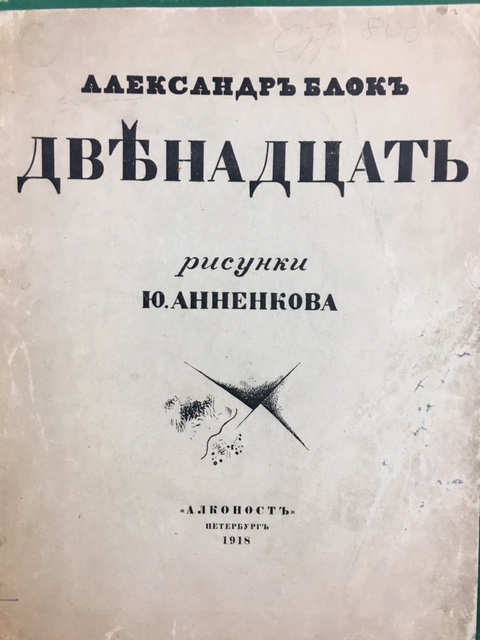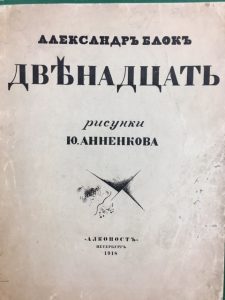RUSSIA’S REVOLUTIONARY SOURCES. PART III: POEMS. “Blok and Revolutionary Aftermath.”


By Jake Hensh
Блок, Александр. Двенадцать. Blok, Alexander. The Twelve. Oxford : Miami Special Collections, 1918.
Throughout the Havighurst Colloquium series on “Russia in War and Revolution,” one of the most edifying and eye-opening experiences was the reading of primary sources. By examining such sources, one can ascertain the thoughts and emotions of individuals actually experiencing the events firsthand; hardly is there a better lens through which to analyze history. During the years 1914 to 1921, the continuum of crisis that Russia experienced,[1] proved to be a complete watershed event, resulting in the eventual downfall of one regime and the beginning of another. In such a series of events, it could easily be posited that the people of Russia experienced a fundamental shift in their national identity.
The Romanov dynasty, which had been one of the only two ruling regimes in modern Russian history, had fallen. Vladimir Lenin and the Bolsheviks filled its place, and the ensuing civil war gave credence to this notion of identity loss. During this time, a variety of different social groups formed under the umbrellas of different colors: The Reds, Whites, Blacks, and Greens, along with other groups that cannot be fit into a revolutionary color palette. In essence, turmoil, chaos, and anarchy had manifested in the wake of the both the war, and the October Revolution. One could ask what this breakdown of infrastructure and outbreak of violence meant for the future of Russia come up with a variety of reactions to these events. One of the predominant ways in which this time period can be analyzed is from a cultural standpoint: how did the intellectuals, artists, and writers react to these events? Alexander Blok provides what could easily be described as one of the most engaging artistic interpretations of this time in his work, The Twelve.
Blok was most widely renowned, and is currently remembered today, as one of the most famous of Russia’s Symbolists. Helen Muchnic describes his work as, “Allusive, mysterious, evocative,” yet “In his lines are the readily understandable Pushkin, Gogol, Dostoevskii.” (Muchnic, 17) Anyone who has not studied Russian history should understand the gravity of such a statement; likening a poet to Pushkin is no laughing matter. Written in 1918, The Twelve, or Dvenadsat’ (pictured above) gives the reader a firsthand look into the mind of Blok himself, and has been described as his crowning achievement (Chukovsky, 140). Of all the incredible primary sources in Special Collections, I found this source to be so captivating in two different ways. The first is through an interpretation and comparison of the poem itself in tandem with the illustrations of the different editions. The illustrators of Blok’s story (predominately Y. Annenkov and V. Masyutin) had many conflicting thoughts and impressions of the work. The ensuing results were entirely different depictions of the same parts of the poem. If the reader is interested in this style of analysis, see the essay by Emily Oneschuk, which provides an in-depth look at the points of view of the illustrators, and Blok himself. The second manner of interpretation is to see how this source speaks to the conflicting national identities that were emerging in Russia at the time.
The Twelve has been occasionally deemed the poem of the Russian Revolution. (Muchnic, 16) During my initial reading, I found myself slightly confused. It appeared disjointed, with little to no unity in coherence or themes. It jumps from depictions of a blizzard, to members of the Red Guard marching through the streets, to prostitution, and finally, to Jesus Christ miraculously appearing and leading the twelve soldiers at the end of the story. These themes and the harsh language employed throughout the work served as the basis for a barrage of criticisms from other scholarly writers and the Bolsheviks themselves: some said it was praising the revolution and therefore should be disowned as Russian. The Bolsheviks, on the other hand, criticized the poem for being overtly religious. Blok denied both of these accusations. He was not a Bolshevik supporter, but merely supported Lenin’s coup because he preferred it to the military violence seen previously in 1917 (The Twelve, Blok), and furthermore hinted at denial that the poem had religious intent, despite criticisms, in his correspondence with Yuri Annenkov (Chukovsky, 151).
Blok’s work would largely deviate from other depictions and reactions to the revolution in its immediate aftermath. For example, on one hand, in his work Ten Days That Shook the World, John Reed provides a Westerner’s account of many of the Bolshevik leaders from a firsthand perspective. He glorified the revolution and Lenin himself praised the work as nothing short of an “accurate” depiction of the events. In it, Reed concludes that, “The Peasants’ Congress expresses its firm conviction that the union of workers, soldiers, and peasants… will consolidate the power conquered by them… and that it will assure in this manner the lasting accomplishment of a just peace and the victory of Socialism.” (Reed, 313)
On the other hand, however, one of the most lauded Russian émigré writers of the time, Ivan Bunin, takes the exact opposite approach. In his work, Cursed Days: A Diary of Revolution, Bunin openly acknowledges that he believes the revolution to be a tragedy and a destruction of true Russian national identity. The collection of stories has been described as, “The (mostly) immediate reactions of a man whose instincts have been proved eminently right; who know that, with the victory of the Bolsheviks, the worst would happen.” (Knorr) Bunin largely expresses his detest with the literature being produced during the time of the revolution, and this massive discontent explains his inevitable departure from the country. Both Reed and Bunin’s reactions offer clear and decisive opinions about the events of the revolution and the Bolshevik’s seizure of power; yet, Blok’s work does not.
As aforementioned, there is no general flow of language, his contemporaries harshly criticized it, and his intentions for the poem were largely unclear. This may lead one to believe that The Twelve is merely a tangential poetic work that defied the Russian revolutionary paradigm. However, if one were to consider the general ambivalent sentiment of educated society in Russia at the time of its publication, the disorganized nature of the poem makes perfect sense. Upon its completion, Blok considered himself a genius. What he sought to accomplish was not to portray the revolution from a particular point of view, or make a statement about which side he supported; he simply attempted to illustrate the world around him. In the wake of a continuum of crisis in Russia in 1918, there was chaos, uncertainty, and a general ambivalence that permeated through Petrograd about future of the people’s nation. This landscape is captured in The Twelve, and if one finds him or herself confused and lost throughout a reading of this poem, then Blok certainly accomplished his goal of putting the reader into a first person point of view of the uncertainty that was going to prevail.
Works Cited
Блок, Александр. Двенадцать. Oxford : Miami Special Collections, 1918.
Blok, Alexander. The Twelve. Ed. Avril Pyman. Oxford: Special Collections, n.d.
Chukovsky, Kornei. Alexander Blok: A Man and Poet. Oxford: Special Collections, n.d.
Knorr, Katherine. “The New York Times.” 27 June 1998. The New York Times . 10 December 2016 <http://www.nytimes.com/1998/06/27/style/books-cursed-daysa-diary-of- revolution.html>.
Muchnic, Helen. “Alexander Blok.” The Russian Review (1953): 16-24.
Reed, John. Ten Days That Shook the World. Random House: The Modern Library, 1934.
Suggested Readings
For further understanding into some of the themes and other opinions on the revolution mentioned in this essay, see to the following material.
Blok, Alexander. Scythians
Bunin, Ivan Alekseevich, and Thomas Gaiton Marullo. Cursed Days: A Diary of Revolution.
Gorky, Maxim. Untimely Thoughts: Essays on Revolution, Culture, and the Bolsheviks, 1917-1918
Holquist, Peter. Making War, Forging Revolution: Russia’s Continuum of Crisis, 1914-1921
Medvedev, Roy. The October Revolution.
Sanborn, Joshua. Imperial Apocalypse: The Great War and the Destruction of the Russian Empire
[1] The term is Peter Holquist’s from his Making War, Forging Revolution: Russia’s Continuum of Crisis, 1914-1921 (Harvard University Press, 2002).
Jake Hensh is a first-year MA student in Political Science.